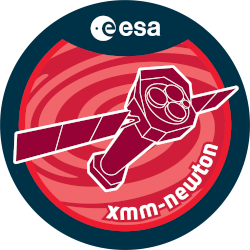

| Proposal ID | 067206 |
| Title | What causes the dispersion of the O-star X-ray luminosities ? |
| Download Data Associated to the proposal | https://nxsa.esac.esa.int/nxsa-sl/servlet/data-action-aio?obsno=0672060101 |
| DOI | https://doi.org/10.5270/esa-loy8ag4 |
| Principal Investigator, PI | Dr Hugues Sana |
| Abstract | O-type X-ray luminosity scales with their bolometric luminosity according tocanonical relation: log L_X/L_bol ~ -7. Yet, significant dispersion is observedaround this relation. Binarity was often considered as a natural explanation tothe observed dispersion but recent investigations tend to disprove thisstatement. We propose to investigate the impact of magnetic wind confinement onthe X-ray properties of O stars, and whether or not it can explain the spreadaround the canonical relation. The nearby young open cluster, IC2944, hosts arich late-type O-star population and is ideally suited for our purpose. It willallow us to investigate with unprecedented details a region of the parameterspace where magnetic confinement is expected to have the strongest impact. |
| Publications |
|
| Instrument | EMOS1, EMOS2, EPN, OM, RGS1, RGS2 |
| Temporal Coverage | 2012-01-01T09:42:07Z/2012-01-01T21:20:37Z |
| Version | 17.56_20190403_1200 |
| Mission Description | The European Space Agencys (ESA) X-ray Multi-Mirror Mission (XMM-Newton) was launched by an Ariane 504 on December 10th 1999. XMM-Newton is ESAs second cornerstone of the Horizon 2000 Science Programme. It carries 3 high throughput X-ray telescopes with an unprecedented effective area, and an optical monitor, the first flown on a X-ray observatory. The large collecting area and ability to make long uninterrupted exposures provide highly sensitive observations. Since Earths atmosphere blocks out all X-rays, only a telescope in space can detect and study celestial X-ray sources. The XMM-Newton mission is helping scientists to solve a number of cosmic mysteries, ranging from the enigmatic black holes to the origins of the Universe itself. Observing time on XMM-Newton is being made available to the scientific community, applying for observational periods on a competitive basis. |
| Creator Contact | https://www.cosmos.esa.int/web/xmm-newton/xmm-newton-helpdesk |
| Date Published | 2013-01-27T00:00:00Z |
| Last Update | 2025-01-27 |
| Keywords | "log l_x", "parameter space", "magnetic confinement", "rich late type", "bolometric luminosity", "xray properties", "star population", "strongest impact", "magnetic wind confinement", "canonical relation", "natural explanation", "investigations tend" |
| Publisher And Registrant | European Space Agency |
| Credit Guidelines | European Space Agency, Dr Hugues Sana, 2013, 'What causes the dispersion of the O-star X-ray luminosities ?', 17.56_20190403_1200, European Space Agency, https://doi.org/10.5270/esa-loy8ag4 |